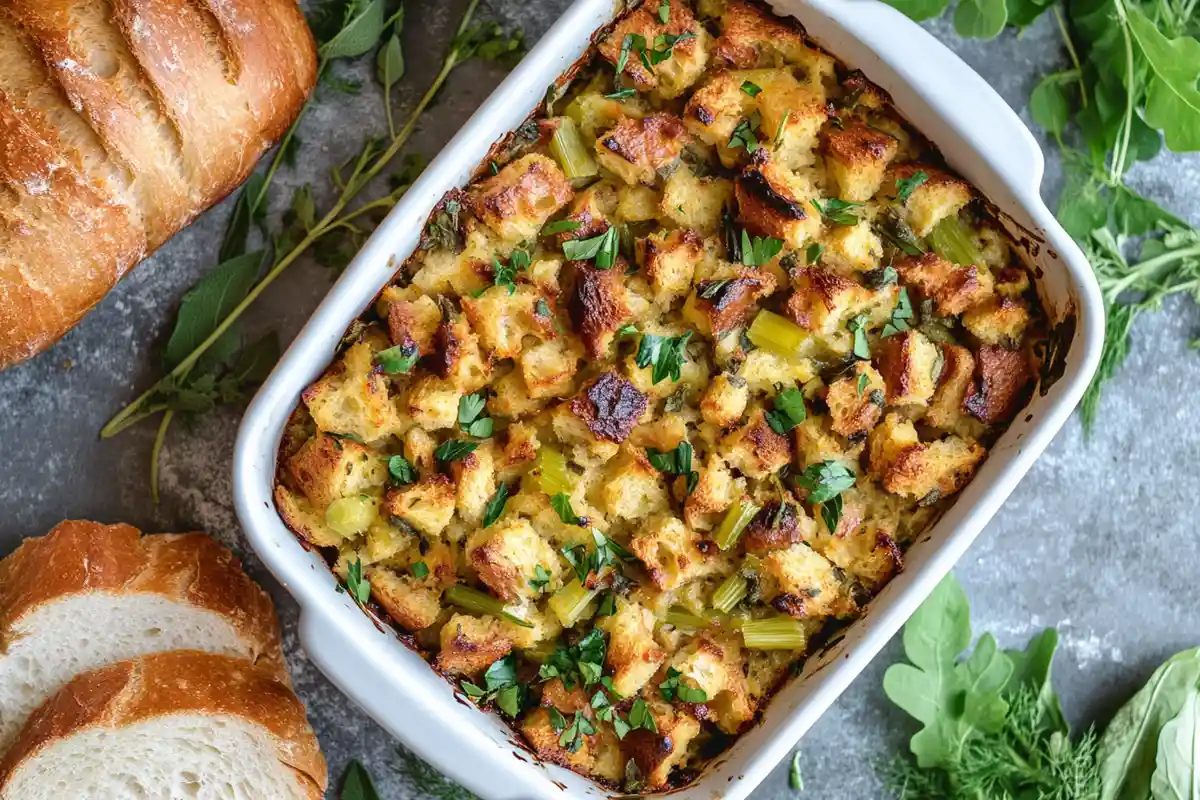Stuffing is a timeless favorite on holiday tables, but the bread you choose can make or break this dish. Enter sourdough bread—a tangy, chewy, and hearty alternative that elevates stuffing to a new level. In this guide, you’ll learn everything from why sourdough shines in stuffing to crafting a recipe that will delight your guests. Plus, we’ll answer all your pressing questions, like how to prepare sourdough and avoid common pitfalls.
If you’re a sourdough enthusiast, there’s so much more to discover:
Learn how to turn your sourdough discard into delicious treats with Sourdough Discard Pumpkin Muffins or Sourdough Discard Soft French Bread. For something sweet, try the Sourdough Discard Sugar Cookies. Craving something savory? Whip up comforting Sourdough Discard Dumplings and Sourdough Garlic Bread Recipe These recipes are sure to inspire your next sourdough adventure!
Table of Contents
Introduction to Sourdough Stuffing Recipe
A Holiday Favorite With a Tangy Twist
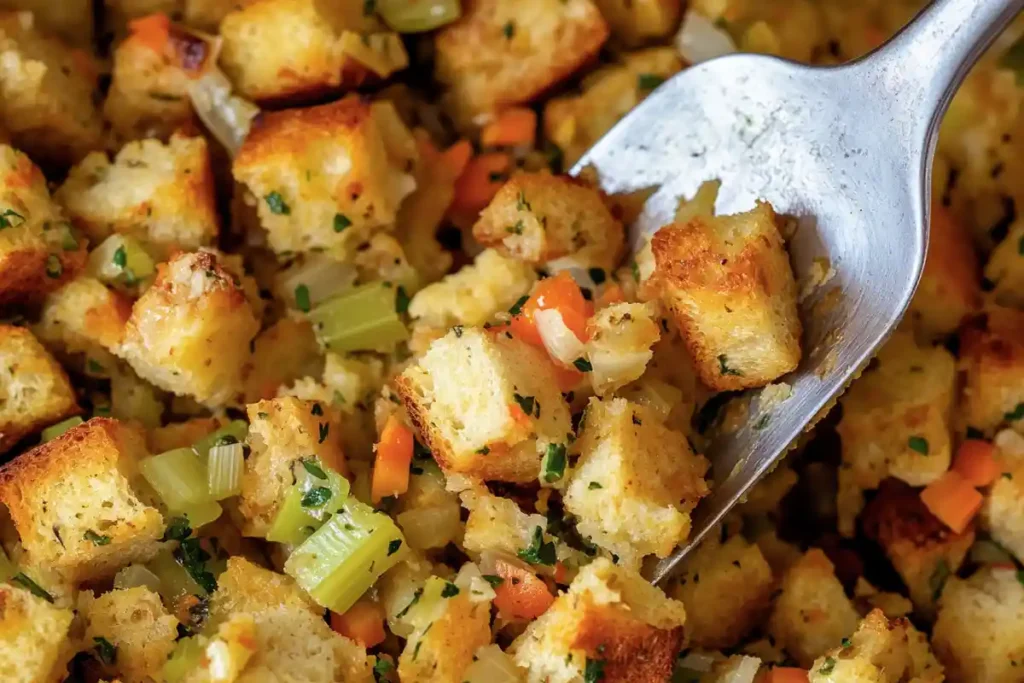
Stuffing has long been the unsung hero of holiday meals, but not all stuffing is equal. Enter sourdough stuffing: a recipe that combines tradition with the tangy, hearty flavors of sourdough bread. Whether you’re a long-time fan of stuffing or looking to upgrade your side dishes this season, this recipe will transform your holiday table.
Why sourdough? It’s more than just bread—an ingredient packed with flavor, texture, and versatility. From its slightly chewy interior to its perfectly crispy crust, sourdough creates a stuffing that stands out. Pair it with fresh herbs, aromatic vegetables, and a touch of broth, and you’ve got a spectacular dish.
In this guide, we’ll dive deep into what makes sourdough stuffing so special, how to prepare it step by step, and tips for perfecting the recipe. Plus, we’ll answer your most common questions to ensure you always nail this dish. Let’s start crafting a side dish that will become a new family tradition!
Why Sourdough is Perfect for Stuffing
What Makes Sourdough Bread Unique for Stuffing?
When creating an unforgettable stuffing, sourdough bread is a game-changer. Its unique qualities, such as its natural fermentation process that develops its tangy flavor, make it a flavorful backdrop for savory ingredients like herbs, onions, and broth. Every bite has a depth that other bread types simply can’t match.
Another standout feature is its texture. The crusty exterior and chewy crumb hold well with broth and seasonings, ensuring your stuffing is not a mushy mess. Plus, sourdough’s slightly firm structure creates those golden, crispy edges we all love.
The Role of Natural Fermentation
Natural fermentation isn’t just a fancy baking term; it’s the secret sauce behind sourdough bread’s success. Wild yeast and lactic acid bacteria in the dough create its signature tanginess and help preserve the bread longer—perfect for prepping stuffing ahead of time. This fermentation also breaks down gluten, making sourdough easier to digest.
Texture and Crustiness of Sourdough
The crunchy crust and dense interior are ideal for absorbing liquid without falling apart. Unlike soft bread, sourdough retains its integrity during baking, creating a delightful contrast between crispy and moist textures. That is precisely why it’s the perfect candidate for a stuffing recipe that pleases everyone at the table.
Health Benefits of Using Sourdough
Sourdough doesn’t just taste better; it’s better for you, too. Its fermented goodness and minimal ingredients make it packed with nutrients that white bread often lacks. Choosing sourdough for stuffing is not only delicious but also a smart and healthy choice.
Digestive Advantages
Thanks to fermentation, sourdough bread contains prebiotics and a lower glycemic index, making it gentler on your stomach. It’s particularly helpful during the holidays when rich foods can overwhelm digestion.
Sourdough as a Nutritious Alternative
With fewer preservatives and more whole ingredients, sourdough brings a nutritional edge to your dish. It retains essential minerals like magnesium and zinc while delivering more fiber than processed bread. So, as you savor every bite of your sourdough stuffing, you can feel good about its benefits for your body.
By choosing sourdough for your stuffing, you’re not just making a flavor statement but prioritizing texture, health, and culinary tradition. It’s a bread that stands the test of time and holiday feasts!
Step-by-Step Sourdough Stuffing Recipe
Ingredients Needed for Sourdough Stuffing
Before diving into the preparation process, round up all the ingredients you’ll need for this sourdough stuffing recipe. The key to a mouthwatering stuffing lies in fresh, high-quality ingredients that harmoniously create an irresistible flavor profile.
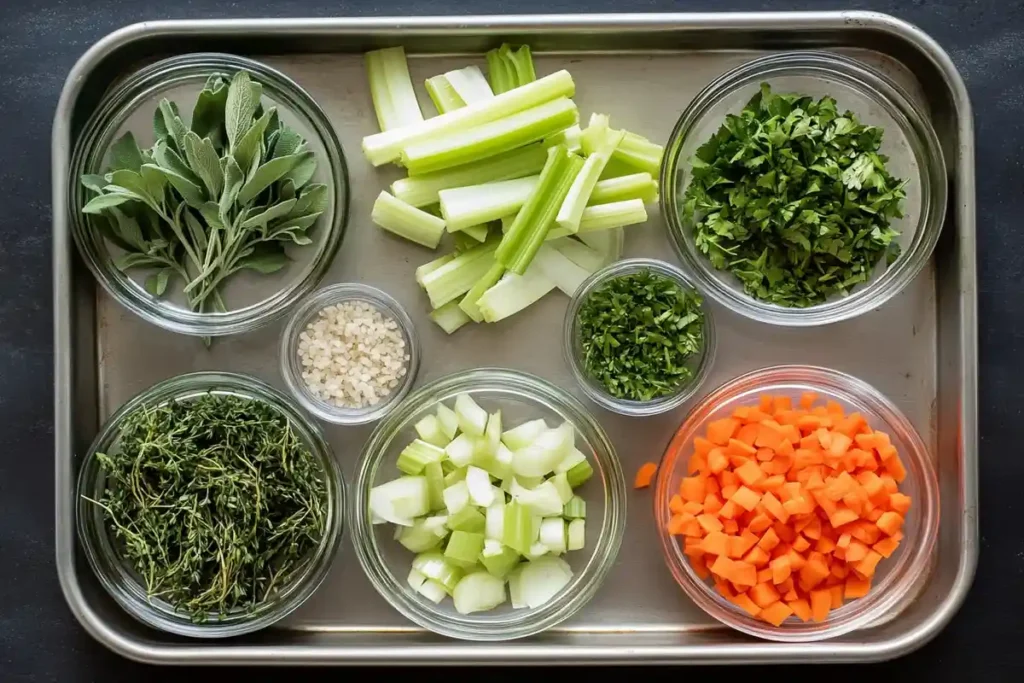
- Sourdough bread (preferably a day or two old), cubed
- Unsalted butter
- Yellow onion, diced
- Celery stalks, finely chopped
- Fresh herbs (like parsley, sage, rosemary, and thyme), chopped
- Garlic cloves, minced
- Chicken or vegetable broth (low sodium)
- Eggs, lightly beaten
- Olive oil (optional, for added moisture)
- Salt and freshly ground black pepper to taste
Pro Tip: For a creative twist, consider adding dried cranberries, toasted nuts, or cooked sausage for an extra layer of flavor.
Preparing the Sourdough Bread
How to Dry Sourdough for Stuffing
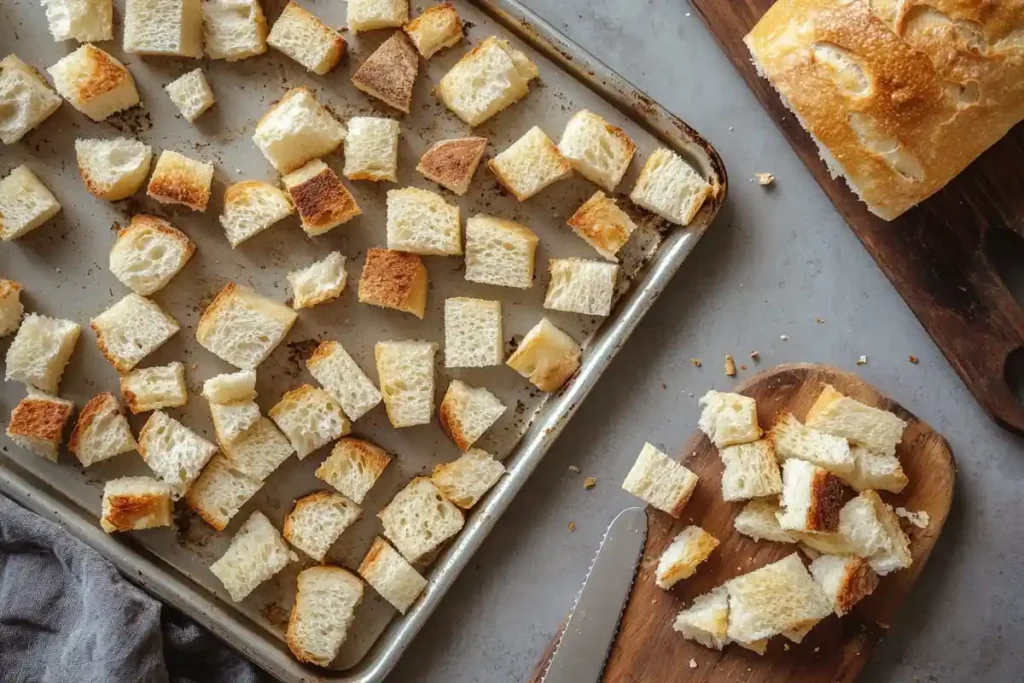
Drying sourdough bread is essential to achieving the perfect stuffing texture. If the bread is too fresh, it will become overly soggy when baked. Here’s how to dry it:
- Air Drying Method: Cube the sourdough and spread it on a baking sheet. Leave it uncovered at room temperature for 24–48 hours.
- Oven Drying Method: Preheat your oven to 250°F (120°C). Spread the cubed bread evenly on a baking sheet and bake for 15–20 minutes, stirring occasionally. The bread should be dry but not browned.
What Not to Do with Sourdough
Avoid using overly fresh sourdough bread, as it can lead to a gummy stuffing texture. Similarly, don’t skip the drying process—it’s critical for absorbing the broth and retaining structure.
Cooking the Sourdough Stuffing
Preparing Aromatic Vegetables
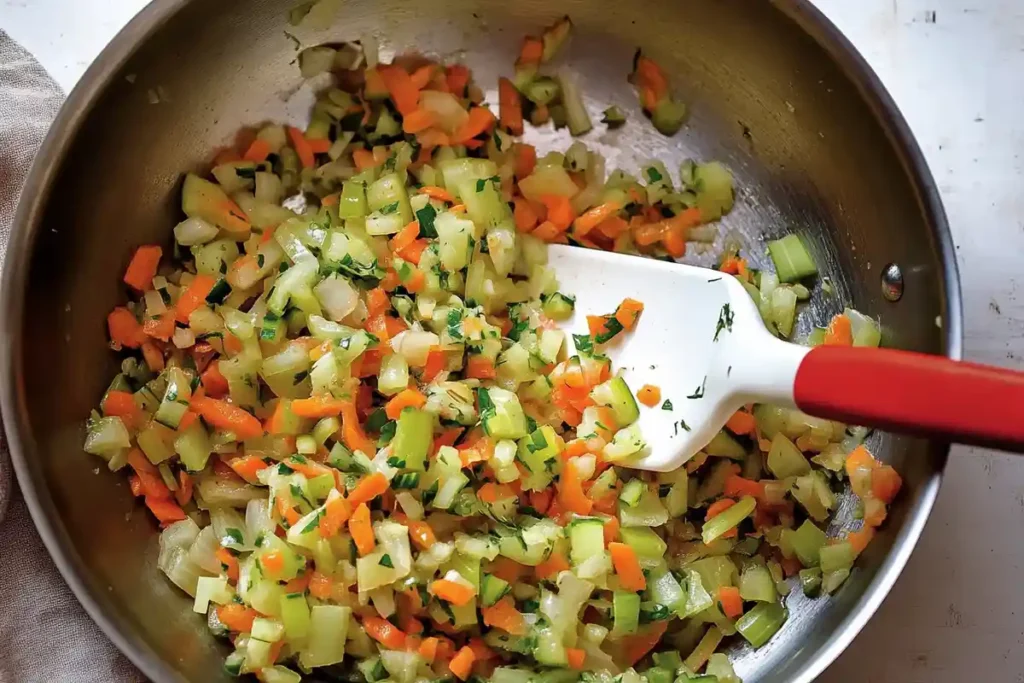
The base of any great stuffing begins with aromatic vegetables. In a large skillet, melt butter over medium heat. Add diced onions, celery, and minced garlic. Cook until the vegetables are soft and fragrant, about 5–7 minutes. Season lightly with salt and pepper to enhance the flavors.
Adding Broth and Seasoning
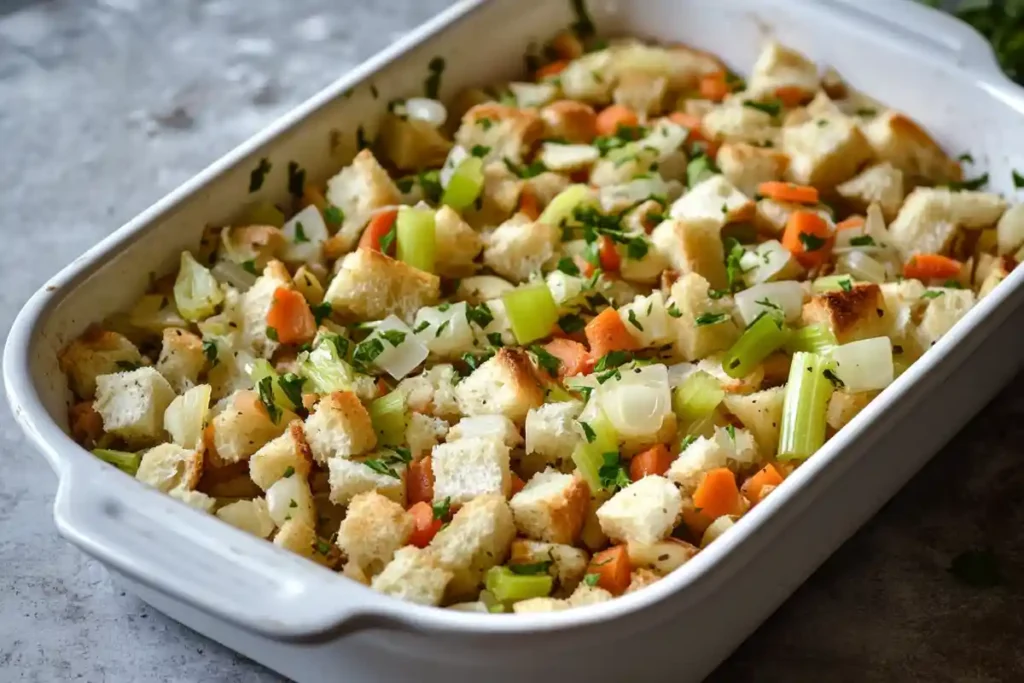
In a mixing bowl, combine the dried sourdough cubes and sautéed vegetables. Pour in the broth gradually, tossing the mixture gently to ensure even absorption. Add beaten eggs, which help bind the stuffing, and sprinkle in fresh herbs for a burst of flavor.
Pro Tip: Add broth a little at a time to prevent the stuffing from becoming overly soggy. Aim for a consistency that’s moist but not dripping.
Baking to Perfection
Transfer the mixture into a greased baking dish, spreading it evenly. Cover the dish with foil and bake in a preheated oven at 375°F (190°C) for 25 minutes. Then, remove the foil and bake for 15–20 minutes to achieve a crispy, golden top.
When the stuffing is baked to perfection, let it cool slightly before serving. The result? A sourdough stuffing that’s crispy on the outside, soft on the inside, and packed with holiday-worthy flavors.
By following these steps, you’ll create a dish that’s not only a showstopper on the dinner table but also a testament to the versatility and charm of sourdough bread.
Tips, Tricks, and FAQs
Expert Tips for the Best Sourdough Stuffing
Picking the Right Sourdough Bread
When selecting sourdough for stuffing, not all loaves are created equal. Choose a bread that’s crusty on the outside and dense on the inside. Avoid bread with added flavors like olives or raisins unless they complement your dish. Day-old sourdough is ideal because it’s firm enough to hold up to the liquid but fresh enough to bring out its tangy flavor.
Using Fresh Herbs and Spices
The flavor of stuffing largely depends on the herbs and spices you use. Fresh parsley, sage, rosemary, and thyme are classics that pair beautifully with sourdough bread. If you want to add depth, try a pinch of nutmeg or a dash of smoked paprika. Don’t forget to season with salt and pepper to taste.
The Secret Ingredient in Sourdough Bread
Ever wonder what makes sourdough so unique? The answer lies in wild yeast and lactic acid bacteria. This natural fermentation process creates sourdough’s signature tangy flavor while improving its texture and digestibility. No wonder it’s the star ingredient for an unforgettable stuffing recipe.
Frequently Asked Questions
How Do You Dry Sourdough for Stuffing?
Drying sourdough is simple and essential for great stuffing. Cut your sourdough into evenly sized cubes, then air-dry them on a baking sheet for a day or two, or bake them in a low-temperature oven (250°F/120°C) for 15–20 minutes until dry but not toasted.
What Not to Do with Sourdough?
Avoid using overly fresh or excessively stale bread. Fresh sourdough won’t absorb liquid properly, making your stuffing soggy, while stale bread will crumble too easily. Also, avoid sourdough with intense or unusual flavors that could overpower the dish.
What Kind of Bread Is the Best to Use for Stuffing?
While sourdough is a top contender due to its texture and tangy flavor, other bread types can work too. Baguettes, ciabatta, or even cornbread are great options, but sourdough remains the best choice for its ability to soak up flavors while maintaining structure.
What Is the Secret Ingredient in Sourdough Bread?
The magic of sourdough lies in its wild yeast and natural fermentation process. This creates its distinct flavor and enhances the bread’s health benefits and makes it a perfect ingredient for savory dishes like stuffing.
Additional Tricks for Perfect Sourdough Stuffing
- Balance Moisture Levels: Too much liquid leads to soggy stuffing, while too little makes it dry. Add broth slowly and mix until the bread is moist but not wet.
- Crispy Edges: Bake uncovered for 15–20 minutes to achieve that irresistible golden crust.
- Add Unique Twists: For added flavor, mix in roasted chestnuts, dried cranberries, or caramelized onions. These simple additions can elevate your stuffing to gourmet levels.
By keeping these tips in mind and avoiding common mistakes, your sourdough stuffing recipe will always turn out perfect. These insights and a little practice ensure that your dish becomes a family favorite for years.
Final Thoughts
Why You’ll Love This Sourdough Stuffing Recipe
Stuffing is a quintessential dish for holiday gatherings, and with sourdough bread as the star ingredient, it transforms into something truly extraordinary. Sourdough’s tangy flavor, hearty texture, and health benefits make it a superior choice to traditional bread options.
This recipe combines the best of both worlds: the crispy edges everyone fights over and the soft, flavorful interior that melts in your mouth. By using high-quality ingredients, fresh herbs, and a few pro tips, you can craft a stuffing that’s delicious and memorable.
So, as you gather with loved ones, let this sourdough stuffing recipe be the centerpiece of your meal. It’s a dish that brings warmth, comfort, and a touch of sophistication to your holiday table. Don’t wait—start prepping your sourdough, gather your ingredients, and let the magic unfold in your kitchen. Your taste buds (and guests) will thank you!
Happy cooking, and here’s to creating new traditions with a stuffing recipe as special as the moments it accompanies.

